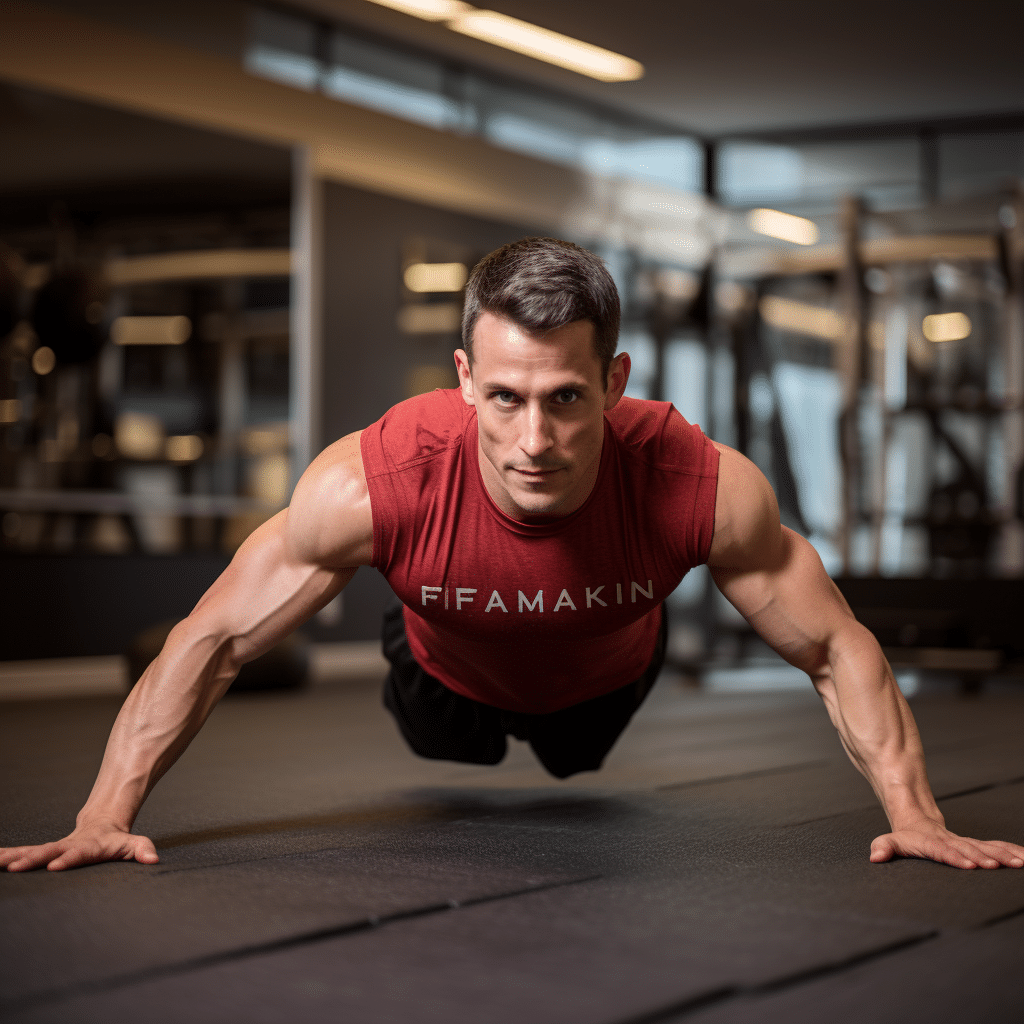Introduction
Does Planking Help With Pushups: Push-ups and planks are two popular exercises that often go hand in hand in fitness routines. While push-ups primarily target the chest, shoulders, and triceps, planks are renowned for their core-strengthening benefits. The question arises does planking help with push-ups. Is there a correlation between these two exercises that can enhance your fitness journey. We will explore the synergy between planking and push-ups and determine whether incorporating planks into your workout routine can improve your push-up performance.
Push-ups are a fundamental upper body exercise, demanding both strength and endurance. They are a great measure of overall upper body fitness and have countless variations to cater to different skill levels. On the other hand, planks are a static exercise that engages the core muscles, helping stabilize the body during various activities. We’ll delve into the science behind these exercises, examine the muscle groups involved, and provide practical tips on how to incorporate planks to potentially boost your push-up prowess.
Whether you’re a fitness enthusiast looking to maximize your gains or a beginner aiming to improve your push-up form, understanding the connection between planking and push-ups is essential. So, let’s explore the potential benefits and the right way to integrate planking into your push-up routine. But can this core strength developed through planking translate into better push-up performance.

Can plank help you do push-ups?
If you can hold a plank for a full minute, that’s awesome. If you can only hold it for five seconds, that’s great, too! Either way, you’ll be developing your muscles and working toward getting better at pushups.
Yes, performing planks can certainly help you do push-ups. Both exercises target the core muscles and engage various other muscle groups, making them complementary. Planks primarily focus on building strength in the core, including the abdominal muscles, lower back, and stabilizing muscles. When you maintain a solid plank position, you’re indirectly improving your ability to keep your body in a straight line during push-ups, which is essential for proper form and reducing the risk of injury.
To make planks more effective for push-up preparation, you can incorporate variations like side planks, forearm planks, or high planks. These variations engage different muscle groups and provide a well-rounded core workout. Transitioning from a plank position into a push-up position and back can be a helpful way to build the necessary strength and stability for push-ups. A strong core is crucial for maintaining a stable and aligned body position during push-ups.
While planks are a valuable exercise to enhance your push-up performance, it’s essential to mastering push-ups also requires working on the specific muscles involved in the push-up movement, such as the chest, triceps, and shoulders. Therefore, incorporating a combination of planks and push-up-specific training will yield the best results in improving your push-up ability.
How many push-ups is equal to a plank?
Similar to that question, we have a slightly more interesting one: 1-minute plank is equivalent to how many push-ups? The short answer is that for every minute you can hold a plank, you should be able to do at least 15 regular push-ups.
It’s challenging to directly equate the number of push-ups to a plank because they are fundamentally different exercises that work various muscle groups. Planks primarily engage the core muscles, while push-ups target the chest, shoulders, and triceps. However, you can make a rough comparison in terms of the time spent holding a plank and the number of push-ups you can do.
A general is that holding a plank for 1 minute is roughly equivalent to doing 10 to 15 push-ups in terms of the effort required. This is a very rough estimate and can vary greatly from person to person based on individual strength, fitness level, and technique.
To see how planks and push-ups relate to your own fitness level, it’s best to perform both exercises separately and track your progress over time. Over time, you can observe how improvements in core strength through planks can lead to better push-up performance. Nevertheless, the two exercises complement each other and don’t have a strict one-to-one equivalence.
Is 1 minute plank good?
Try performing the plank for a minimum of one minute at a time. Start by doing 1 plank a day to slowly 3 to 10 a day to reap the maximum benefits. Then, slowly also try side planks which can help improve your flexibility.
Holding a 1-minute plank is a good benchmark of core strength and endurance for many individuals. It’s a respectable goal, especially for beginners or those looking to improve their core stability. A 1-minute plank requires a solid engagement of the rectus abdominis, transverse abdominis, and obliques, which are key core muscles.
However considered “good” can vary depending on your fitness level and goals. Seasoned athletes or advanced fitness enthusiasts might aim for longer plank times, like 2 or even 3 minutes, while those new to exercise may find 1 minute quite challenging. The thing is to work at a level that challenges you and gradually progresses over time.
A 1-minute plank can be an excellent starting point for building core strength and stability. As you become more proficient, you can extend your plank time, add variations, or incorporate other core exercises into your routine for a well-rounded approach to core fitness.
Why am I strong but can’t do push-ups?
It’s not all about the arms, your pecs, deltoids, triceps all play a part and so do your abs to keep good form. If you struggle start doing them on your knees and then build to a full push up. You can do it, consistency is key, just keep practicing and increasing the number daily.
Being strong in one area of fitness doesn’t necessarily translate directly to strength in all exercises. Push-ups require not only upper body strength but also proper technique and muscle coordination. Several factors can contribute to someone feeling strong yet struggling with push-ups.
Lack of Technique: Even if you have considerable upper body strength, poor push-up technique can hinder your performance. Correct form involves maintaining a straight body line and using the right muscles for the movement. Core strength is crucial for stabilizing your body during push-ups. If your core is weak, it can make push-ups more challenging, even if your upper body is strong.
Muscle Imbalances: You might have developed strength imbalances. Being strong in certain muscles but weak in others can affect your ability to perform specific exercises. To improve your push-up ability, it’s essential to work on your technique, strengthen your core and improve your muscle coordination.
Limited Range of Motion: Some individuals with good upper body strength might not have the necessary flexibility or mobility to perform full push-ups with proper form. Gradually progress by performing modified push-ups, such as knee push-ups or incline push-ups, to build strength and work your way to full push-ups.

How to do push-ups if you are weak?
Using an elevated surface such as a chair or wall to place your hands on while doing a pushup will allow you to perform the same movement but with less weight. This helps you practice proper form and gradually build core and arm strength. The less you are inclined, the easier it will be.
Wall Push-Ups: Begin with wall push-ups. Stand facing a wall, place your hands on the wall at shoulder height, and step your feet away from the wall. Bend your elbows to lower your chest toward the wall, then push back up. This variation reduces the amount of body weight you have to lift. Find a sturdy surface, like a bench or a step, and place your hands on it, with your feet on the ground. This is a modified push-up that reduces the weight on your upper body, making it easier to perform.
Knee Push-Ups: Start with knee push-ups. Kneel on the floor and place your hands on the ground, then lower your chest to the floor while keeping your knees on the ground. This variation reduces the intensity of the exercise. Stand on an elevated surface and lower yourself slowly to the ground in the push-up position. This focuses on the eccentric phase of the push-up and can help build strength.
Eccentric Push-Ups: Perform regular push-ups, but emphasize the lowering phase (the eccentric phase). Lower yourself to the ground as slowly as possible, and then use your knees or an incline to return to the starting position. This helps you work on your strength and control. Consistency is key. Gradually increase the number of repetitions you can perform with each progression. Over time, you’ll build the strength and muscle endurance needed to do standard push-ups.
What is the fastest way to increase push-ups?
Create a Push-Up Routine. The best way to stick to a workout and build up strength for your push-ups is to create a regular routine and make it part of a weekly workout regimen. You might start your cardio or strength training workout with a few sets of push-ups, or add them to a circuit of high-intensity exercises.
Consistent Practice: The fastest way to increase your push-up count is through consistent practice. Begin with your current maximum number of push-ups and aim to do a set of push-ups every day, gradually increasing the number of repetitions. For example, if you can currently do 10 push-ups in a set, try doing 11 or 12 the next day, then gradually work your way up. Building strength and endurance takes time, so don’t rush the process to avoid injury. Push-ups are a compound exercise that engages multiple muscle groups, and progress might be slow initially.
Variation: Incorporate different types of push-ups into your routine, such as diamond push-ups, wide-arm push-ups, and decline push-ups. This not only challenges your muscles differently but also helps you build strength and endurance faster. Engaging in strength training exercises that target the muscles used in push-ups, such as chest presses, tricep dips, and shoulder presses, can help increase your overall upper body strength, making it easier to do more push-ups.
Proper Form: Ensure that you maintain proper form while doing push-ups. This includes keeping your body in a straight line, engaging your core, and lowering yourself until your chest is a few inches from the ground. Good form reduces the risk of injury and maximizes the effectiveness of each repetition. Give your muscles time to recover with adequate rest and prioritize a balanced diet to fuel your workouts. Protein, in particular, is essential for muscle recovery and growth.
What happens when you plank for 30 days?
All in all, I lost two inches from my waistline and four inches from my belly. These results are nothing to scoff at from just 30 days of a one-minute workout. My posture also improved, which speaks to my increased core strength. As part of this process, I realized that consistency is key.
Improved Core Strength: Planking for 30 days can significantly enhance your core strength. You’ll likely notice increased muscle definition and improved endurance in the abdominal muscles, obliques, and lower back. A stronger core can lead to improved posture. By engaging the muscles responsible for maintaining an upright position, you may find it easier to stand and sit with a straight back, reducing the risk of slouching and related discomfort.
Enhanced Stability: Planks also work the stabilizing muscles in the shoulders, back, and hips. Over time, this can lead to better overall stability, which can be beneficial for various physical activities and reduce the risk of injury. Isometric exercises like planks can boost your metabolism. A faster metabolism can help with weight management and fat loss when combined with a balanced diet.
Mental Benefits: Consistently completing a challenge like a 30-day plank can instill a sense of discipline and accomplishment. It can also improve mental resilience as you push through discomfort and maintain focus during the exercise. By strengthening the muscles that support the spine, planking may help reduce the risk of lower back pain.
Variation in Ability: Over the course of 30 days, you’re likely to experience an increase in your plank duration. Initially, you might struggle to hold a plank for more than a minute, but by the end of the challenge, you could see significant improvements in your endurance. While planking for 30 days can yield these benefits, to maintain a balanced fitness routine that includes cardio, flexibility training, and other forms of strength training.
Is a 20 minute plank good?
If you can actually do 20 minutes straight of planks, you’re either a liar or you should be a model on this site. Most people can’t do this in one straight go – especially with good form. Your goal should be to do as much as you can, in as good of form as you can, with as few breaks as possible.
Exceptional Core Strength: Holding a plank for 20 minutes demonstrates an exceptional level of core strength and muscular endurance. Most individuals can only hold a plank for a few minutes at most. Achieving a 20-minute plank requires extensive training and practice. It’s not something that happens overnight; it’s the result of months or even years of progressive training.
Mental Toughness: Prolonged planking also showcases mental toughness. Enduring the discomfort and fatigue of such a long hold demonstrates extraordinary mental resilience and discipline. While a 20-minute plank is impressive, be cautious of overuse injuries. Holding a plank for this extended period can put excessive strain on the shoulders, wrists, and lower back, leading to potential injuries if not done with proper form and caution.
Practicality: In real-world scenarios, holding a plank for 20 minutes is not necessary for most people. Shorter, well-executed planks can yield many of the benefits associated with this exercise, such as core strength and improved posture. A well-rounded fitness routine should include a variety of exercises to target different muscle groups and fitness components. While planks are excellent for core strength, they should be part of a broader regimen that includes cardiovascular exercise, flexibility training, and other forms of strength training.


Conclusion
“Yes.” planking helps push-ups. Adding planks to your workout can boost your push-ups and fitness. Planks strengthen and stabilize the core, allowing you to push yourself further. Planks are a great way to improve push-ups and boost your fitness routine.
Planking not only fortifies your core but also engages secondary muscle groups that play a crucial role in push-ups, such as the chest, shoulders, and triceps. As you progress in your planking abilities, you’ll notice improvements in your push-up stamina, making it easier to perform more repetitions with correct form. So, embrace the power of planks and experience the positive impact they can have on your push-up abilities and overall physical well-being.
To make the most of this synergy between planking and push-ups, consider integrating planks as part of your warm-up or cool-down routines, or even as a standalone workout. By doing so, you’ll reap the benefits of a stronger core and upper body, leading to improved push-up performance and an enhanced overall fitness level.


1 comment
Thank you for your sharing. I am worried that I lack creative ideas. It is your article that makes me full of hope. Thank you. But, I have a question, can you help me?